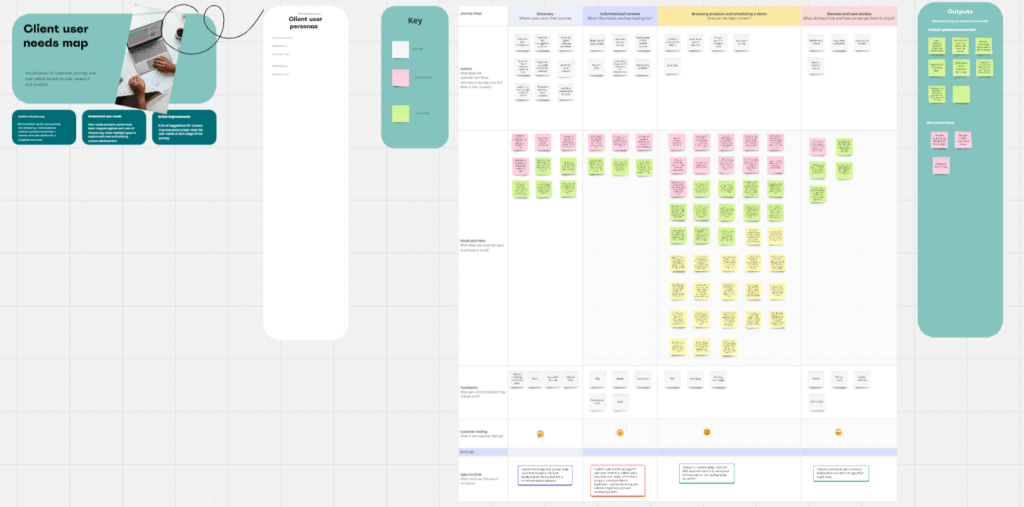Understanding the role of user research within content strategy
Crafting a content strategy that resonates with your audience is paramount to business success. But how do we ensure our content truly addresses user needs? The answer lies in user research – a powerful tool that uncovers invaluable insights about your target audience.
By understanding the intricacies of user research and its application, we can develop content strategies that not only engage but also convert. Let’s explore how user research shapes an effective content strategy and drives meaningful results for your business.
What is user research and how does it form part of a content strategy?
User research provides key insights into a target audience’s wants, needs and questions. These insights form the foundation of any content strategy, as they help to ensure that the content created is based on real data with user experience in mind.
The discovery phase at the beginning of this process is there to identify pain points, keywords and user needs, so we can begin to visualise and respond to the target audience, creating content that caters to their preferences. When defining your content strategy, you should always have user experience at the forefront of your decision making. Insights gathered can help you to produce new content or enhance existing content to respond to key user challenges, and answer the all important questions your users have when searching for a solution, product or service. These findings will help you to understand your ideal customer profile, and create content that speaks to them.
Why is user research important?
By forming an understanding of a business’ target audience, we can create a content strategy that is informed by content design principles and validated by the data and evidence collated. Having an understanding of pain points for existing users can also provide the opportunity to create content that responds to recurring challenges. For example, user research can identify if prospective customers struggle to understand descriptive jargon for specific products or struggle to locate a product on a website, which in turn creates a barrier to conversion. In response, the content strategy can be adjusted to incorporate more “Plain Language”, and the content design can be amended to make that information easier to access. Altogether, this works to produce copy that effectively resonates with the target audience.
User research methods
User research methods can take many forms. At Distinctly, we leverage our expert experience to quantitative and qualitative research that is data led, producing compelling narratives that build off of our findings. Qualitative methods explore the needs and motivations of a user evaluating overall user satisfaction and engagement. On the other hand, quantitative methods validate user assumptions by using different options to test user behaviour and outcomes.
1. User interviews
Interviews offer a valuable insight into the experiences and preferences of the user. By conducting one-on-one user interviews, it’s possible to gain a greater understanding of the lived experiences of the users, giving businesses the opportunity to create content that acknowledges and responds to their challenges.
The user interview process begins by sourcing from a pool of current or potential customers. Questions in the interview itself should be open ended giving them the chance to fully articulate their thoughts on their journey to purchase or sign up. Interviews are recorded and transcribed, so that you can delve into valuable insights about the current website or potential gaps in content.
2. User surveys
User surveys measure user satisfaction and overall outcomes. Designed to help content strategists test their hypothesis, the results allow content teams to evaluate their assumptions and consider effective solutions.
Surveys can be sent out to an existing email list of current users, and can focus on different parts of your audience. For example, surveys could be sent out to regular buyers, or those who have only made one purchase through your site. You can even design surveys to target a specific user persona or target market. Questions within the survey should be a predetermined mix of open and closed, so that you can gain both quantitative and qualitative feedback. If you want to encourage more people to take part in your survey, you can incentivise it by offering product discounts or freebies.
3. Sales team/customer service team interviews
Speaking with the sales/customer service teams helps us to better understand what customers are looking for from a business. As these teams interact directly with their audience, they are a fantastic resource that understands the daily wants and needs of their customers. By interviewing them, we can develop a content strategy that serves their needs, as well as the customers. Updated content that answers those common questions for the user on the website before they need to pick up the phone can also save time, resources and money.
4. Keyword research
Designed to show how you can structure content that is optimised for search engines, keyword research offers an invaluable insight into what an audience is searching for. If you understand what your audience is looking for, you can build a content plan that not only effectively responds to their questions, but also appears at the top of their search results.
5. Review scraping
A fantastic way to gain an insight into what your customers are saying about your offering, review scraping can help your business to understand your customer’s journey to purchase, and create or change content to improve it. For example, you may want to gather reviews for your product online, analysing any common trends in the adjectives used to describe them and establishing the average sentiment. These could include positives that can be highlighted in your content (such as “good quality” or “long lasting”) or pain points that need to be addressed (like “slow” or “fragile”).
6. Reddit scraping
Reddit is an often underutilised resource that can help to identify user pain points relating to a business’ brand, service or product. Scraping subreddits helps to do this by identifying keywords and phrases, finding frequent topics of conversation or interest. These insights allow us to produce content that better responds to key audience demographics, ensuring that it provides answers to FAQs and bolsters brand reputation.
7. Social listening/forum research
Social listening tracks conversations and mentions related to a topic or brand across social media. This can be done across commonly used social media platforms like X or LinkedIn, or more niche, specialist industry forums. Whether there are conversations about a specific brand or more broader conversations where the brand is mentioned, with these insights, we can improve user experience by further tailoring content to meet their needs or improve on consistent pain points.
8. Heat mapping
Heat mapping shows how users are interacting with your site. The mapping uses hot spots to indicate how users are “funnelled” through the site, showing where they click through from the home page to purchase. This information helps businesses to identify which content is successfully leading to conversions, and most importantly identify missed opportunities.
9. User behaviour analysis with GA4 data
Google Analytics 4 creates data insights that help us to build responsive content that drives customer conversion. We use GA4 to access user journeys and identify potential friction by looking at user metrics such as bounce rates and time on page. Path explorations help us to visualise user journeys and monitor specific audience groups across a site, which helps us to tailor content that meets their needs whilst also tracking conversions.
User research outputs
Following the user research and gathering of this all important data, the next steps are interpreting that data into actionable insights.
List of pain points and challenges
By creating a list of pain points and challenges, you can gain a clear picture of which areas need improvement, giving you an indication of what you should prioritise when adapting your content. For example, if a lack of information about shipping and delivering is at the top of your pain point list, this should be what you address first.
List of user needs/user stories
From those pain points we can then interpret them as user needs, along with any other information we’ve gathered about the motivators and interests of our users. We can then unify all user needs into a user story format. E.g. As a… Marketing Manager, I want to… better understand the pain points and challenges of my users so I can… provide solutions to their challenges through our content, product or service.
We can then map those pain points and user needs to the user journey in Miro board like the one below. Here we can align the wants and needs of users to each stage of the buying cycle. Miro boards provide a clear visual representation of the findings from the research, creating a clear pathway to any recommendations, such as changes or improvements.

Content strategy and plan
User research findings can be used to outline a content strategy and plan that can effectively respond to the results. A user-centric strategy will include a plan to prioritise content that should be created or updated. Frequent pain points or opportunities should be addressed ASAP, to ensure that your business isn’t missing out on vital traffic or conversions. By having a clearly defined content strategy, you can create content that utilises the findings from your research to build a better overall experience for the user.
The vital role that user research plays in developing a watertight content strategy cannot be understated. The research means that your content is better structured with narratives that serve the needs of your business and the user. Satisfaction all-round. By helping to define the direction of the content with the wants and needs of the user, dynamic content that entices, sparks interest and leads to increased conversion is sure to follow.
Discover how Distinctly’s content strategy services can support you with innovative content that drives traffic and boost conversions on your site. Get in touch today to find out how we can help your business thrive.



